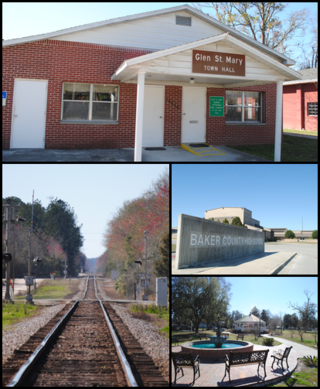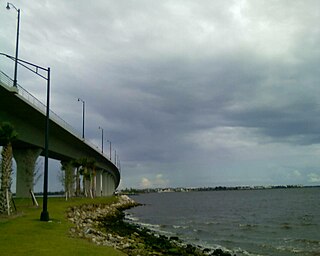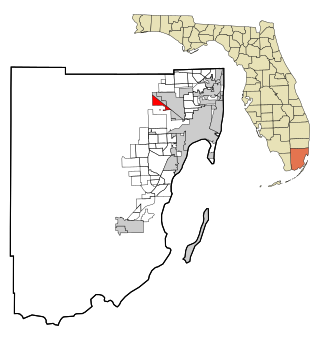
Glen St. Mary is a town in Baker County, Florida, United States. The Town of Glen St. Mary is part of the Jacksonville, Florida Metropolitan Statistical Area in North Florida. The population was 463 at the 2020 census, up from 437 at the 2010 census.

Penney Farms is a town in central Clay County, Florida, United States. It is part of the Jacksonville, Florida Metropolitan Statistical Area. The population was 821 at the 2020 census, up from 749 at the 2010 census.

Beverly Beach is a town in Flagler County, Florida, United States. It is part of the Deltona–Daytona Beach–Ormond Beach, FL metropolitan statistical area. The population was 474 at the 2020 census.

Orchid is a town in Indian River County, Florida, United States. The Town of Orchid is part of the Sebastian–Vero Beach Metropolitan Statistical Area. The population was 516 at the 2020 US Census, up from 415 in the 2010 US Census.

Yankeetown is a town in Levy County, Florida, United States. Its located in North Florida along the Gulf of Mexico. It is part of both the Big Bend Coast and the Nature Coast. In the 2020 census, the population was 588, up from 502 at the 2010 census. It is part of the Gainesville, Florida Metropolitan Statistical Area.

Indiantown is a village in Martin County, Florida, United States. The population was 6,560 at the 2020 census. It is a rural community in the interior of Florida's Treasure Coast region, first established in the early 1900s, then incorporated on December 31, 2017. The village is governed by a mayor and council elected at-large, while day-to-day operations are directed by the village manager.

Jupiter Island is a town located on the barrier island also called Jupiter Island, in Martin County, Florida, United States; the town is part of Florida's Treasure Coast. It is part of the Port St. Lucie metropolitan area. The Town of Jupiter Island is located next to the unincorporated community of Hobe Sound. The population of Jupiter Island was 804 at the 2020 census.

Ocean Breeze, formerly Ocean Breeze Park, is a town on the Indian River in Martin County, Florida, United States. Ocean Breeze and Briny Breezes in Palm Beach County are the only two towns in Florida in which all residents live in a mobile home park bearing the name of the town. The population was 301 at the 2020 census. The population figures do not include the many part-time winter residents from other places. The town is bordered on three sides by the unincorporated community of Jensen Beach.

Sewall's Point is a town located on the peninsula of the same name in Martin County, Florida, United States. The population was 1,991 at the 2020 census. Both the town and the peninsula are named for Capt. Henry Edwin Sewall. It is an eastern suburb of Stuart, which is the county seat of Martin County.

Country Club is a suburban census-designated place located in northwest Miami-Dade County, Florida, United States. It is located in the Miami metropolitan area of South Florida. The CDP is named after the Country Club of Miami, which was established in 1961 in what was then an unpopulated and undeveloped section of the county. The population was 49,967 at the 2020 census, up from 3,408 in 1990.

Homestead Base is a census-designated place (CDP) in Miami-Dade County, Florida, United States. The CDP comprises the extent of Homestead Air Reserve Base plus some surrounding land. It is part of the Miami metropolitan area of South Florida. The population was 999 at the 2020 census.

Medley is a town in Miami-Dade County, Florida, United States. The town is part of the Miami metropolitan area of South Florida. As of the 2020 US census, the population was at 1,056 residents.

Palmetto Estates is an unincorporated area and census-designated place (CDP) in Miami-Dade County, Florida, United States. It is part of the Miami metropolitan area of South Florida. The population was 13,498 at the 2020 census.

Princeton is a census-designated place (CDP) and unincorporated community in Miami-Dade County, Florida, United States. It is part of the Miami metropolitan area of South Florida. The population was 39,208 at the 2020 census, up from 22,038 at the 2010 census.

West Perrine is a census-designated place (CDP) in Miami-Dade County, Florida, United States. It is part of the Miami metropolitan area of South Florida. The population was 10,602 at the 2020 census, up from 9,460 in 2010.

Cinco Bayou is a town in Okaloosa County, Florida, United States. The Town of Cinco Bayou is part of the Crestview–Fort Walton Beach–Destin, Florida Metropolitan Statistical Area. The population was 457 at the 2020 census, up from 383 at the 2010 census.

St. Leo is a town in Pasco County, Florida, United States. The town is a suburb included in the Tampa-St. Petersburg-Clearwater, Florida Metropolitan Statistical Area, which is more commonly known as the Tampa Bay area. It is best known as the home of St. Leo University, Holy Name Monastery and St. Leo Abbey. The population was 2,362 at the 2020 census. Vincent D'Ambrosio currently serves as the commission-elected mayor of the town, elected in 2022.

North Redington Beach is a town in Pinellas County, Florida, United States. It is part of the Tampa–St. Petersburg–Clearwater Metropolitan Statistical Area, more commonly known as the Tampa Bay Area. The population was 1,495 at the 2020 census.

Redington Beach is a town in Pinellas County, Florida, United States. It is part of the Tampa–St. Petersburg–Clearwater Metropolitan Statistical Area, more commonly called the Tampa Bay Area. The population was 1,376 at the 2020 census.

Indian River Shores is a town in Indian River County, Florida, United States. As of the 2020 census, the town has a population of 4,241. Located on Orchid Island, Indian River Shores is bordered by the Atlantic Ocean to the east and the Indian River Lagoon to the west.





















